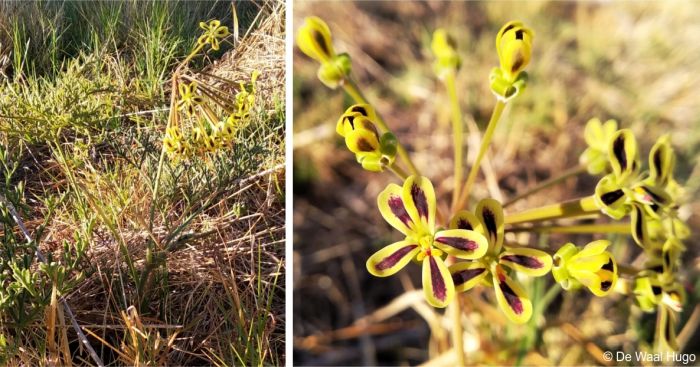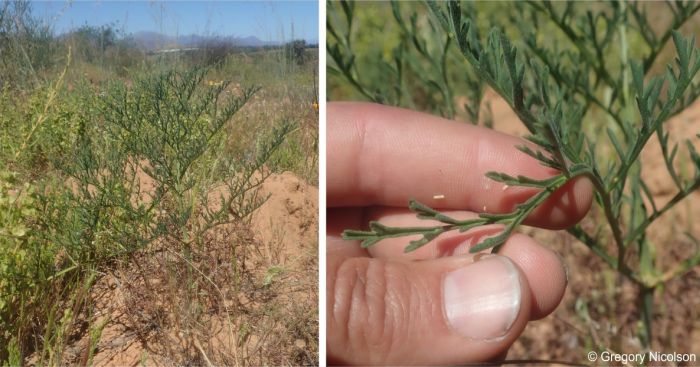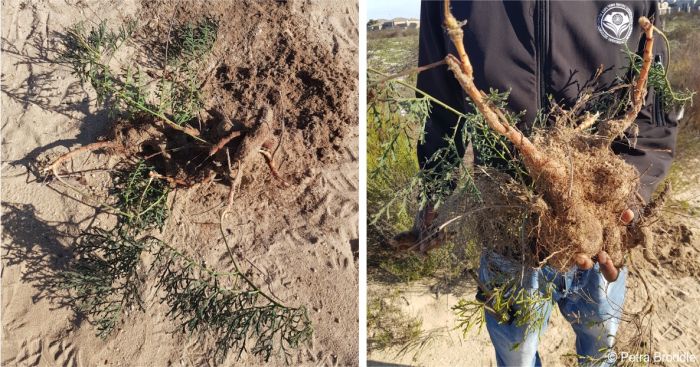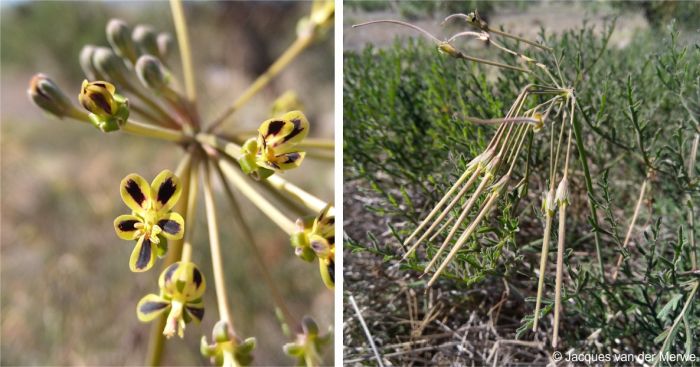Pelargonium multiradiatum
Pelargonium multiradiatum J.C.Wendl.
Family: Geraniaceae
Common names: none
Introduction
Pelargonium multiradiatum is a hardy, floriferous, spring-summer flowering geophytic species from South Africa’s winter-rainfall area.

Description
Description
Geophyte possessing a big, woody tuber and several smaller tubers. Plants can reach up to 500-800 mm tall when flowering. The leaves are dull-green, 200-450 mm long, 180-450 mm wide and divided into 2 to 3 ribbon-like segments (pinnatifid). The petiole is 200-350 mm long, strigose and contains glandular hairs in between. The broadly deltoid stipules are 8-10 mm long, 6-8 mm wide, yellow-green and tinted with pink. The leaves are practically smooth. The inflorescence is a range of approximately of 13 pseudo-umbels, each made up of up to about 30 flowers, on stout, branching peduncles with 15-18 mm diameter. The petals are almost black with narrow, pale yellow margins. Flowering is mainly from spring to early autumn (September to March), with a peak in midsummer, from December to February.

Conservation Status
Status
Given that this species has no current threats, the conservation status is considered as Least Concern (LC) according to the Red List of South African plants.
Distribution and habitat
Distribution description
This species is restricted to the Western Cape, occurring from Clanwilliam southwards to the Cape Peninsula. In this distribution zone it can be found from 150 m at sea-level to altitudes reaching 1 500 m in the Cederberg Mountain range. The climate features predominantly dry, hot summers and rains mainly during the winter. Annual rainfall is between 300 to 400 mm. Plants generally favour sandstone-derived soils. In some instances, it is also common within shale bands in mountainous areas. Pelargonium multiradiatum is a component of low, open fynbos.
Derivation of name and historical aspects
History
The genus name Pelargonium is derived from the Greek word pelargos, meaning ‘a stork’, because the fruit resembles the shape of the beak of a stork. The species name multiradiatum, meaning ‘many rays’ refers to the radiating, many-flowered inflorescences.
The genus Pelargonium belongs the Geraniaceae, a family consisting of more than 800 species and 11 genera. Pelargonium can be found in subtropical and tropical regions such as New Zealand, Madagascar, St Helena, Tristan da Cunha and the continents of Asia, Australia and Africa. Southern Africa is widely acknowledged as the official hotspot for the genus where about 219 of the 270 species can be found. In 1823 Sweet proposed that a new genus be created in order to accommodate certain species. This resulted in it being placed in De Candolle’s new genus Polyactium. Today Polyactium is recognized as a section of the genus Pelargonium.
Pelargonium multiradiatum was amongst those species of Pelargonium published in Harvey’s Flora Capensis Vol. 1 in 1860. Despite its botanical description in 1809, its exact habitat at the time was not known. Its inclusion in the publication was merely because it was successfully cultivated in Europe. The original description was therefore based on cultivated material. Initially thought to be long lost and having its status as a natural species being questioned by well-known Pelargonium botanist, Knuth (in 1912), Salter rediscovered the species on the lower slopes of the Karbonkelberg on the Cape Peninsula in the 1930s. This was followed by a comprehensive description of the species in 1940.
Pelargonium multiradiatum is one of 7 species that make up the Pelargonium section Polyactium. The other 6 are: P. triste, P. anethifolium, P. pulverulentum, P. radulifolium, P. pillansii and P. lobatum. The section Polyactium, which resembles a star, refers to the many-flowered inflorescences of the species, which share some of the following characteristics: the presence of pale-mustard petals, dusk-scented flowers that are almost regular and a well-developed subterranean tuber. With the exception of P. pulverulentum, all other species are exclusively confined to the winter rainfall-region.

Ecology
Ecology
As with several other dusk-scented pelargoniums, it is possible that this ability could lure potential pollinators for nocturnal visits. In such a case it would suggest the pollinator to be a night-flying insect, such as a moth, with a long proboscis.
The seed of all species of Pelargonium appear to be similar, in that it has a feathered, tail-like structure coiled in a spiral arrangement. This tail allow seeds to move better in the wind and acts as device that helps the seed penetrate the soil. This promotes better germination and ultimately survival.
Uses
Use
No medicinal uses have been recorded for this species. The tannin-rich tubers of Pelargonium triste, another species with the section Polyactium, are used in Namaqualand for tanning leather a deep, reddish brown colour. Infusions made from the tubers or leaves are used for treating dysentery, diarrhoea, nausea and as a vermifuge. It is possible that this species could be used similarly.
This species undoubtedly forms part of the plant collection of the avid Pelargonium grower.

Growing Pelargonium multiradiatum
Grow
Pelargonium multiradiatum can be propagated sexually (seed) and asexually (cuttings). Sow seed in late summer. Germination may take between 14 to 21 days. Pot seedlings into a well-draining soil mixture. Strike cuttings at any time of the year. Dip the cuttings into a rooting hormone and place in a rooting medium like coarse river sand. The rooted cuttings can then be potted into a well-draining soil mixture.
In the Kirstenbosch Living Plant Collection, this species is grown in a container as part of the pot-collection. It receives water throughout the year, but being a winter-rainfall species, it receives minimal to no water in summer (every second week) and regular watering from mid-autumn to the end of spring. Feeding is a slow-release fertilizer in late winter to early spring and one liquid application monthly in the run-up towards flowering.
This species is ideally suited to sandy soils or a well-drained rockery in a garden. Alternatively, or should porcupines present a challenge, they can also feature in display-pots. Grow in full shade.
In the garden, it can be used with some of the following companion species, which include shrubs, herbaceous perennials and annuals: Osteospermum incanum, Salvia aurea, Muraltia spinosa, Felicia filifolia, Roepera flexuosa, Pelargonium betulinum, P. triste, P. fulgidum, P. gibbosum, P. capitatum, Jordaaniella anemiflora, Coleonema album, Cotyledon orbiculata, Dimorphotheca pluvialis, Ursinia anthemoides, Ursinia cakelifolia, Senecio arenarius, S. elegans, S. maritimus, Lampranthus amoenus, L. aureus, Cotula duckittiae, Cleretum bellidiforme, Carpanthea pomeridiana, Cineraria geifolia, Felicia tenella, Didelta carnosa var. tomentosa and Concosia pugioniformis subsp. pugioniformis.
References
- Adams, T. 2006. Pelargonium triste. (L.) L’Hér. (Geraniaceae). PlantZAfrica. Online.http://pza.sanbi.org/pelargonium-triste.
- Broddle, P. 2022. Observation of Pelargonium multiradiatum, Cape Farms, Cape Town. iNaturalist. Online. https://inaturalist.org/observations/145746803.
- Hugo, D.W. 2024. Observation of Pelargonium multiradiatum, Table View, Cape Town. iNaturalist. Online. https://www.inaturalist.org/observations/196895928
- Maggs, G.L., Vorster, P., Van der Walt, J.J.A. & Gibby, M. 1999. Taxonomy of the genus Pelargonium (Geraniaceae): the section Polyactium. 3. The subsection Polyactium. South African Journal of Botany 65(3):115-143.
- Manning, J. & Goldblatt, P. 2012. Plants of the Greater Cape Floristic Region 1: the Core Cape Flora. Strelitzia 29. South African National Biodiversity Institute, Pretoria.
- Nicolson, G. 2021. Observation of Pelargonium multiradiatum, Citrusdal area, Western Cape. iNaturalist. Online. https://www.inaturalist.org/observations/101819037.
- Oliver, R. 2020. Pelargonium gibbosum (L.) L’Hér. (Geraniaceae). PlantZAfrica. Online. http://pza.sanbi.org/pelargonium-gibbosum.
- Oliver, R. 2020. Pelargonium tomentosum Jacq. (Geraniaceae). PlantZAfrica. Online. http://pza.sanbi.org/pelargonium-tomentosum.
- Pelargoniums: An Herb Society of America Guide. 2006. The Herb Society of America. http://www.herbsociety.org.
- Raimondo, D., Von Staden, L., Foden, W., Victor, J.E., Helme, N.A., Turner, R.C., Kamundi, D.A. & Manyama, P.A. (eds) 2009. Red list of South African plants. Strelitzia 25. South African National Biodiversity Institute, Pretoria.
- Salter, T.M. 1940. Some notes on Pelargonium multiradiatum Wendl. Journal of South African Botany 6:127-130.
- Stearn, W. 2002. Stearn's dictionary of plant names for gardeners. Timber Press, Portland, Oregon.
- Van der Merwe, J. 2022. Observation of Pelargonium multiradiatum, Bellville, Cape Town. iNaturalist. Online. https://www.inaturalist.org/observations/105660837.
- Van der Walt, J.J. & Vorster, P.J. 1981. Pelargoniums of southern Africa, vol. 2. Juta, Cape Town, Johannesburg.
- Van der Walt, J.J.A. 1977. Pelargoniums of southern Africa. Purnell, Cape Town.
Credits
Roger Oliver
Kirstenbosch National Botanical Garden
June 2024
Acknowledgements: the author thanks Gregory Nicolson, De Waal Hugo, Jacques van der Merwe and Petra Broddle for making their images available via iNaturalist.
Plant Attributes:
Plant Type: Bulb
SA Distribution: Western Cape
Soil type: Sandy
Flowering season: Spring, Early Summer, Late Summer
PH: Acid
Flower colour: Yellow
Aspect: Full Sun
Gardening skill: Easy
Special Features:
Horticultural zones








Rate this article
Article well written and informative
Rate this plant
Is this an interesting plant?
Login to add your Comment
Back to topNot registered yet? Click here to register.